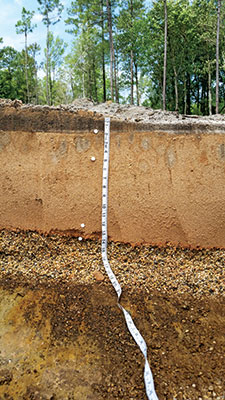Formation of clay bands in sand putting greens

Thin clay band at the interface of sand and gravel (14-inch depth) in a nine-year-old putting green in Mississippi.
In 2014, we observed thin bands of clay in the sand putting greens of a golf course in Mississippi. These layers resulted in reduced water infiltration, saturated soils and a decline in turfgrass density.
The greens, constructed in 2005 following USGA guidelines, had a root zone blend of 90:10 sand and calcined clay. These layers had formed at the interface of sand and gravel, with clay contents ranging from 1.7 percent to 3.8 percent.
We proposed three hypotheses to explain the formation of these layers: 1) Clay was present in the sand and subsequently moved downward, 2) Clay originated from the breakdown and subsequent translocation of the calcined clay amendment in the root zone mix, or 3) Clay from the underlying compacted subgrade moved upward through the gravel when it was saturated and into the sand.
In each hypothesis, the preferential retention of water in the sand above the gravel resulted in clay accumulation at this boundary. We characterized the clay with X-ray diffraction and found that the mineralogy of the clay bands was different from both the calcined clay amendment and the underlying subgrade. Our findings suggest that the calcined clay soil amendment did not break down and contribute to the layers. It also is unlikely that clay moved up from the compacted subsoil into the sand.
The clay bands most likely originated from clay that was present in the root zone mix during construction. The layers contained 1.7 percent to 3.8 percent clay, yet current USGA recommendations allow up to 3 percent clay in construction mixes. We are conducting USGA-funded research on clay movement and accumulation in root zones containing a range of clay content. We also are examining how irrigation water chemistry interacts with clay mineralogy to induce swelling, deflocculation and dispersion. This will provide details about the interactions between soil and water chemistry, and could improve construction recommendations to avoid the formation of layers in putting green soils.
Glen Obear is a Ph.D. candidate, and Bill Kreuser, Ph.D., is a turfgrass scientist at the University of Nebraska-Lincoln. You may reach Glen at glenobear@gmail.com for more information.
photo by: Glen Obear








